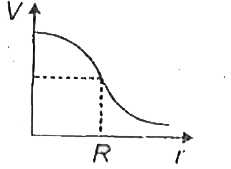At a distance of 5cmand10cm outward from the surface of a uniformly charged solid sphere, the potentials are 100Vand75V, repectively. Then.
ptentail at its surface is 15V.
the charge on the spehre is (5/3)×10−10C.
the electric field on the surface is 1500V/m
the electric potential at its centre is 225V.
The correct Answer is:A, C, D
Step by step video, text & image solution for At a distance of 5 cm and 10 cm outward from the surface of a uniformly charged solid sphere, the potentials are 100 V and 75 V, repectively. Then. by Physics experts to help you in doubts & scoring excellent marks in Class 12 exams.
Similar Questions
The electric field intensity at a distance 20cm from the centre of a uniformly charged non conducting solid sphere of radius 10cm is E.Then what is the electric field intensity at a distance 5cm from the centre it will be.....
View SolutionAn object is at a distance of d=2.5cm from the surface of a glass sphere with a radius R=10cm. Find the position of the final image produced by the sphere. The refractive index of glass is μ1.5.
View Solution
Knowledge Check
- Question 1 - Select One
At a point 20cm from the centre of a uniformly charged dielectric sphere of radius 10cm, the electric field is 100V/m. The electric field at 3cm from the centre of the sphere will be
A150V/mB125V/mC120V/mDZero - Question 2 - Select One
Which graph best represents the variation of electric potential as a function of distance from the centre of a uniformly charged solid sphere of charge of radius R ?
A
 B
B C
C D
D
- Question 3 - Select One
A spherical shell of radius 10 cm is carrying a charge q. If the electric potential at distances 5 cm, 10 cm and 15 cm from the centre of the spherical shell is V1,V2 and V3 respectively, then
AV1=V2>V3BV1>V2>V3CV1=V2<V3DV1<V2<V3
The given graph shows variation (with distance r from centre) of (A)Electric field of a uniformly charged conducting sphere (B)Electric field of a uniformly charged non-conducting sphere (C) Potential of a uniformly charged hollow sphere (D)Potential of a uniformly charged non- conducting solid sphere
View SolutionWork done in moving a positive charge from the centre of a hollow uniformly charged sphere to its surface is zero. Does it imply that the potential is zero inside the sphere?
View SolutionTwo conducting spheres of radii 3 cm and 1 m are separated by a distance of 10 cm in free space. If the spheres are charged to same potential of 10 V each, then the force of repulsion between them is
View SolutionTwo spherical conductors A and B of radii 1mm and 2mm are separated by a distance of 5 cm and are uniformly charged. If the spheres are connected by a conducting wire, then at equilibrium condition, the ratio of the magnitude of the electric fields at the surface of spheres A and B is
View SolutionTwo spherical conductors A and B of radii 1mm and 2mm are separated by a distance of 5 cm and are uniformly charged. If the spheres are connected by a conducting wire then in equilibrium condition, the ratio of the magnitude of the electric fields at the surfaces of spheres A and B is
View Solution

